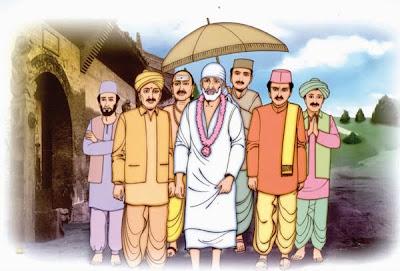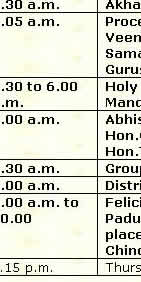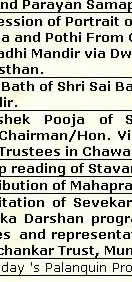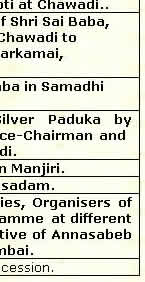Happy Thursday to all,
Yesterday I had posted Invitation from Shirdi Sai Baba Sansthan for Chavadi's Centenary Celebration .This signifies that on December 10, 2009, the tradition of Chavadi procession will be completing 100 years. To make this occasion memorable Sansthan had started unique celebration by taking Baba's portrait and Paduka on 10th Dec 2008.To mark this great occasion I am publishing a post on various details about Baba's most revered place 'Chavadi'.Many of has visited Shirdi and our visit to holy land is complete only when we visit Dwarkamai and Chavadi after having darshan in Samadhi Mandir .
There are many places of importance which are also must see but pilgrimage to Shirdi is incomplete without taking darshan of Baba in Darwakami and Chavadi. Keeping in mind the importance and divinity of these places I am bringing a complete write up on all the places in Shirdi where Baba lived,moved and spent His life. These details shall be followed in coming post .
Content of the post is the extract of various details about
Chavadi available from various resources devotees are welcome to
contribute more information on this if they have by mailing me at
this ID.I have also tried to gather old and rare pictures of Sai
Baba's Chavadi .
Old and Rare Picture of Chavadi.
History of Chavadi :
Chavadi means “village
office”, and was the place where taxes were collected, village
records kept and visiting officials were put up.It also meant
“meeting place of Villagers”.
Baba used to always spend most of the time in Dwarkamai but after
one particular incident Baba started spending alternate nights in
Chavadi. There are two Chavadis in Shirdi one south facing and the
other north facing, right chavadi is now the Nagar Palika reading
room .South Chavadi is where all the Sai devotee go for Baba's
darshan.

Sai
Baba is intimately connected with South facing Chavadi, as he used
to sleep here on alternate nights, during the last decade of his
life .It so happened that on one wild and stormy night, in 1909 it
was raining heavily, and water was coming through the leaky walls of
the /Dwarkamai mosque. The devotees tried their best to persuade
Baba to move out, if only until the water had subsided, but Baba did
not want to go. Eventually, they virtually forced him to leave, by
picking him up and half-carrying him to Chavadi. From that day
onward, Baba spentalternate nights here.
.jpg)
.jpg) Chavadi
i
Chavadi
i
s also very significant to Sai devotees as it played a major role in
the inception of formal worship of Baba. Once Baba started sleeping
at Chavadi, the custom arose of offering regular arati to him on his
arrival from the mosque/Dwarakamai. This was Sej (night) Arati.
Later, Kakad (morning) Arati was offered when he woke up there.
On entering this south facing Chavadi, one can see a plaque on which
is written "Shri Sai Nath Babanchi
Lakshmi Bai Damodar Babre, Chinchanikar Chavadi, Saka 1859".
 Damodar
Babre came from the village Chinchani -Thana district. Hence, every
one called him Anna Chinchanikar. He and his wife came and lived in
Shirdi, and were devoted to Baba. For many years they did selfless
service not expecting or asking anything from Baba. One day Shyama
asked Baba "why He had not blessed
this couple with a son?. Other devotees were blessed and their
wishes were fulfilled". Baba smiled and said
Damodar
Babre came from the village Chinchani -Thana district. Hence, every
one called him Anna Chinchanikar. He and his wife came and lived in
Shirdi, and were devoted to Baba. For many years they did selfless
service not expecting or asking anything from Baba. One day Shyama
asked Baba "why He had not blessed
this couple with a son?. Other devotees were blessed and their
wishes were fulfilled". Baba smiled and said
"Has it happened so, that whenever anybody has asked me for any thing, I have not given to him "?
Baba being Antaryami saw that
the son, would only continue the name of Anna for one generation.
While Baba wanted Anna's name to last for a very, very, long time.
A civil suit regarding his fields was then in progress at Dhanu.
Anna time and again asked Baba about the outcome.Baba always used to
say "Allah Bhala Karega". A
famous lawyer, Achyut Narayan Khare, was handling his case. Once
someone wrote to Anna saying that he had lost the case. Anna ran to
Kaka Dixit and informed him, so, both of them came to Baba at
Dwarakamai. As they were entering the Dwarakamai, Baba shouted
"This old man has no faith in Me,
throw away that letter".
Later the lawyer informed him that he had won the case and Rs.
1,8007- along with the court costs was awarded to him. Anna and Kaka
went to Baba with the letter in hand. Baba simply said
"Have you got faith in Me now?"
Anna placed the letter at Baba's feet and said "Baba this is all
yours, I do not want it". Baba refused to accept the money saying
that He was a Fakir. Anna begged Baba to accept it. This
conversation went on for some time. Ultima
tely Kaka suggested that the sum could be used to repair the
Chavadi, and it should be named after Anna and his wife Lakshmi Bai.
The sitting platform along the outside of the front wall is a later
addition.
Inside Chavadi:
Inside Chavadi is a large portrait of Baba which was painted by Ambaram from Nausari in Gujarat after Baba had given him darshan in a dream in 1953 after his Mahasamadhi. At the time, Ambaram was only eighteen years old. Ambaram painted this portrait from his dream vision. The Nausari villagers were touched by Baba and Ambaram’s painting of him, so they collected donations, framed it, and brought it to Shirdi and handed it over to the Sansthan. It was first proposed to keep this portrait in the Samadhi Mandir. But as the statue was being prepared this portrait was placed in the Chavadi. Baba used to sit at this very place during Sej (night) arati and Kakad (early morning) Arati.
On the left of the painting is a plain, wooden bed on which Baba was given his last bath after he passed away in Dwarkamai. These days, the bed is taken out each Thursday and the palanquin is placed on it. In the same corner next to the bed is a wheelchair which was presented to Baba when he was suffering from asthma, but which he never used.These items are now kept in Museum and are not in Chavadi.
Raj Upchar Photo:

The right portion of the building contains the framed photo of the
cross-legged Baba ,kept in grand attire on Silver Sinhasan(hence it
is known as the Raj Upchar photo) and this is the picture that is
taken out on procession on festivals and each Thursday in the Palki
and Rath.

The silver throne where it is kept is where Baba used to sleep.It
has been there since Baba’s time. Women were not allowed in this
section and thistradition is maintained till today, only men and
children are allowed in this area.
Every Thursday after the noon Aarti it is brought out and kept on
the wooden cot for darshan .Than it is taken to Samadhi Mandir
,where after the “Raj Upchar “ it is taken in the Palki along with
Baba’s Paduka and Satka Aarti is done in the Chavadi and chillum is
offered to Baba in this portrait. Than it is taken back to Samadhi
Mandir for Sej Aarti .It is brought back to Chavadi after Kakad
Aarti the next day. Chavadi is opens from 5 a.m. to 9 p.m.
Wooden Cot.
After Baba took Mahasamadhi on
15Ih October, 1918, (Tuesday) at 2.30 PM His body was laid on this
wooden cot for three days, till 17Ih October, 1918 (Thursday). As
there were differences between His devotees as to where to intern
Him (Ref, Ch. 43-44), on this wooden cot His 'last bath was
performed. With due formalities His body was brought inprocession to
Dagdi Wada (Samadhi Mandir). In the Garbha Gruh i.e. central portion
reserved for Murlidhar "HIS samadhi" was made.
This cot was previously in Dwarakamai now it is housed in the
Chavadi. Every Thursday it is taken out and placed in front of the
Chavadi and Baba's palki is placed on it. After Arati this cot is
placed along the western wall of the Chavadi.
Wheel chai
In 1886 Baba made an attempt
to cross the borderline. He suffered from a severe attack of Asthama,
and to get rid of it He took samadhi for 72 hours. Mahalsapathi
guarded His body well (Chapt 44). Baba coughed off and on. This
chair was presented by a devotee, for Baba to use, and move about in
His old age. However, Baba moved freely and occasionally with the
help of His devotees. Baba did touch this chair, and kept it, but
never made use of it. This chair is placed on the north-western
corner of the Chavadi and now it is placed in museum.
Glass lamp shades.
Radhakrishna Ayi was a young widow from Pandharpur
who came and stayed in Shirdi. She loved Baba and wanted Him to have
a royal sansthan service. She tirelessly worked to this end and,
often asked rich devotees to bring beautiful things for Baba (her
Vittal). Kaka Mahajani on the advice of Radhakrishna Mai brought
these glass globes for Baba's lamps. Govardhan Das brought silk
curtains, and new dresses for the volunteers who carry the umbrella
and chamars .
Around the time when Dwarkamai was renovated, Chavadi was also
upgraded. The mud walls were neatly plastered, huge mirrors were
hung, glazed tiles replaced the mud floor and glass chandeliers were
suspended from the ceiling.
Procession to Chavadi During Sai Baba’s Time:
One cannot help marveling at
Baba. We know that he did not like such pomp and paraphernalia and
we have seen the importance to him of holy poverty (“faqiri”) and
his reluctance to allow devotees to worship him, yet here he was
allowing himself to be lead to Chavadi in an extravagant display of
adoration.
In describing the scene a few moments before the procession
Hemadpant in Sai Satcharitra hints at Baba’s response. People were
singing bhajan, some were decorating the palanquin, rows of oil
lamps were burning, Shyam Sunder stood waiting fully decorated, then
"Tatya Patil came to Baba with a party of men and asked him to get
ready. Baba sat quiet in his place till Tatya came and helped him to
get up by putting his arm under Baba’s armpit”.
Baba wore on his body the usual kafni, took His satka (short stick)
under His arm-pit and after taking His chillum (tobacco-pipe) and
tobacco and placing a cloth over His shoulder became ready to start.
Then Tatya threw a golden-embroidered beautiful Shela (Shawl) over
His body. After this Baba, moving a little the bundle of fuel-sticks
lying behind with His right toe and then extinguishing the burning
lamp with His right hand, started for the Chavadi.
Then all sorts of muscial instruments, tashe, band and horns and
mridang, gave out their different sounds; and fire-works exhibited
their different and various coloured views.

Men and women singing Baba 's name started walking, making bhajan to
the accompaniment of mridang and veena. Some danced with joy and
some carried various flags and standards. The Bhaldars announced
Baba's name when He came on the steps of the Masjid.
On the two sides of Baba stood persons, who held chavaris and others
who fanned Baba. On the way were spread folds of cloth on which Baba
walked on, being supported by devotees' hands. Tatyaba held the left
hand and Mhalasapati the right and Bapusaheb Jog held the chhatra
(umbrella) over His head. In this fashion Baba marched on to the
Chavadi.
When procession reached near Maruti Mandir, Baba used to halt there
for some time. Baba used to look at Hanuman ji's idol and gestured
something with His hands by moving them in various directions. Baba
only knows the meaning of these strange gestures!
The fully decorated red horse, named Shyamakarna led the way and
behind him were all the carriers, waiters, musical players and the
crowd of devotees. Hari-nama (the name of the Lord) chanted to the
accompaniment of music rent the skies as also the name of Sai. In
this manner the procession reached the corner when all the persons
that joined this party seemed well-pleased and delighted.
On coming to this corner Baba stood facing the Chavadi and shone
with a peculiar lustre. It seemed, as if the face of Baba glittered
like dawn, or like the glory of the rising sun. Baba stood there
with a concentrated mind, facing the north, as if He was calling
somebody. All the instruments played their music while Baba moved
His right arm up and down for some time. Kakasaheb Dixit at this
time came forward with a silver plate containing flowers besmeared
with gulal (red powder) and threw them on Baba's body off and on.
The musical instruments played their best at this juncture and
Baba's face beamed with steady and added radiance and beauty, and
all the persons drank this lustre to their hearts' content. Words
fail to describe the scene and splendour of this occasion. Some
times Mhalasapati began to dance being possessed or obsessed by some
deity, but all were surprised to see that Baba's concentration was
not in the least disturbed.
With a lantern in his hand Tatya Patil walked on Baba's left side
and Bhagat Mhalasapati on the right, holding with his hand the hem
of Baba's garment. What a beautiful procession and what an
expression of devotion! To witness this, men and women, poor and
rich, flocked together there. Baba walked very slowly. Bhaktas
followed on both sides with love and devotion. With joy pervading
the whole atmosphere of the place, the procession reached the
Chavadi.

The Chavadi was also fully
decorated with a good white ceiling, mirrors and many sorts of
lamps.
On reaching it Tatya went ahead and spread an asan and placing a
bolster made Baba sit there and made Him wear good angaraksha
(coat). Then the devotees worshipped Him in various ways. They put
on His head a mugut (crown) with a tuft above, placed garlands of
flowers and jewels round His neck and marking His forehead with
musk-mixed vertical lines and a dot (as Vaishnava devotees do) they
started at Him for long to their hearts' content. They changed His
head-dress now and then and held it aloft on the head, fearing that
Baba might throw it away. Baba knew the heart of them all and meekly
submitted to all their methods without objection. With these
decorations He looked wonderfully beautiful.
Nanasaheb Nimonkar held the Chhatra (umbrella) with its beautiful
pendants which moved in a circle with its supporting stick.
Bapusaheb Jog washed the feet of Baba in a silver dish and offered 'arghya'
and worship with due formalities, then besmeared His arms with
sandal paste, and offered tambul (betel-leaves). Baba sat on the
asan (gadi), while Tatya and others kept standing and falling at His
feet. When Baba sat on the gadi supporting Himself against the
bolster, devotees on both sides waved chamars and fans. Shama then
prepared the chillim and handed it over to Tatyaba who drew a flame
out of it by his breath and then gave it to Baba. After Baba had His
smoke, it was given to Bhagat Mhalasapati and then it was passed
round to all.
After this function was over, devotees put garlands of flowers on
His neck and gave Him nose-gays and bunches of flowers for smelling.
Baba who was dispassion or non-attachment incarnate, cared a fig for
all these necklaces of jewels, and garlands of flowers and other
decorations; but out of real love to His devotees, He allowed them
to have their own way and to please themselves.
Finally Bapusaheb Jog waved the arati over Baba, observing all
formalities, the musical instruments playing thier auspicious tunes.
When this arati was over, the devotees returned home one by one
saluting Baba and taking His leave. When Tatya Patil, after offering
chillim, attar (scent) and rose-water, rose to depart, Baba said to
him lovingly - "Guard Me, go if you
like, but return sometimes at night and inquire after Me."
Replying in the affirmative Tatyaba left the Chhavadi and went home.
Then Baba Himself prepared His bed. He arranged 50 or 60 white
chadders one upon another and thus making His bed, went to rest.
In the morning devotees would
come to Chavadi and take Baba again to Dwarkamai. This was followed
till Baba's Samadhi
Again and again this scene was re enacted, and it is one replete
with poignancy and poetic tension. A great saint, adored as a living
deity, but to whom any personal worship was distasteful, yet
allowing it out of love for his devotees and sympathy for their
human longings.
"What a beautiful procession and
what an expression of devotion! With joy pervading the whole
atmosphere of the place .That scene and those days are gone now.
Nobody can see them now or in the future.”
However, we are fortunate
that those days are not completely gone. We can experience something
of that splendor and fervid devotion even today, as each Thursday
evening, a similar procession takes place with
Baba’s photo in honour of that tradition.
It is a passionate, understrained – yet exalted – celebration of Sai
Baba. If you have a chance, be sure to see the procession – it is an
exhilarating experience!(Apart from Thursdays, Sansthan organises
Palkhi Procession on the first day of celebration of Ramnavami,
Gurupoornima, Dashera (Punyatithi) and also on Mahashivratri and
eleventh day of full moon phase of Ashadh month as per Hindu
calender {July-August month as per English calendar}.
In the evening, Baba’s satka
and padukas (in this case, a pair of Baba’s leather sandals) are
displayed in front of his sacred tomb from 7.30, until they are
carried out at the beginning of the procession at 9.00 p.m.The
Samadhi Mandir is even more crowded,as people are eager to touch and
pay their respects to these sacred objects, which are accessible
only at this time.The sense of occasion is enhanced by the hearty
singing of melodious bhajan by some villagers,while outside a group
of young men from a local youth organization move rhythmically to a
rapid drumbeat.
Thousands of devotees -local and from all over the world participate
in this incredible procession and make their souls satisfied with
cries of Baba's name with deep devotion. The path on which
procession passes is dawned with mixture of cow dung, mud and water
with beautiful rangolis drawn. Few fortunate married women perform
arti of Palkhi. Many famous music bands participate in this
procession to make the atmosphere submerged in music, which is
another form of devotion.
At about 9.15 the procession moves out of the Samadhi Mandir, to a
flurry of horns, cries and waving fans. At the centre is the
garlanded portrait of Baba (the one from Chavadi) carried reverently
by the great-grandson of one of Baba’s dearest devotees, Tatya Kote
Patil, (Tatya Kote is son of Baijabai, who used to search for Sai
Baba in jungles for serving Baba with lunch when Baba used to roam
in jungles.Sai Baba called Baijabai as her sister and Tatya Kote
Patil, used to call Sai Baba as Mama, meaning maternal uncle. It is
mentioned in Sai SatCharitra that Tatya Kote Patil used spend nights
in Dwarkamai with Sai Baba and other devotee Shri Mahlsapati.)and
another of his relatives .

Tatya Kote Patil are preceded
by one of the mandir staff carrying the padukas and satka. Other
staff follows, dressed in Maharashtrain-style festive red tunics and
turbans. The procession wends its way through the street lined with
eagerly waiting crowds, and the music and excitement crescendos as
people strain for a glimpse of the photo and padukas. Many throw
flowers, and guns fire marigolds, petals and confetti into the air.
The procession enters Dwarkamai about ten minutes later, where again
there is an assembled crowd waiting for its arrival and jostling for
a view. Here the photo is placed on the decorated silver
palanquin to the accompaniment of more exuberant bhajan. This takes
about fifteen minutes. Mandir staff and locals then carry the
palanquin to Chavadi, where people are waiting inside and out.
As the palanquin approaches
Chavadi, we come to the climax of the evening. The palanquin is
parked outside, and the picture, draped in gold embroidered red
velvet, is carried inside Chavadi and greeted as if Baba himself
were entering.
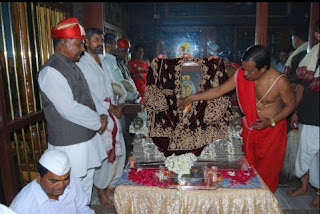
People may prostrate (if they have the space !), shout his name, say a silent prayer, or gaze longingly on his face. Baba’s picture is then settled into place on a silver throne and arati is performed.
Finally, the whole group
returns to the Samadhi Mandir. Here, a local person receives the
satka and padukas, and the Kote brothers hand back the picture and
collect a coconut as prasad. The prasad is kept beside Baba’s statue
until the final night arati is over (around 10 p.m.). The picture is
returned to Chavadi after morning arati the next day.
During the procession, lalkari is performed at prescribed places
along the route. There is no direct translation for
“lalkari”, but it means the
shouting of slogans or words of praise, such as
“Long live Sai Baba!” There
are three specific places where this is done during the utsav, just
as there were when Baba made the trip by foot, nearly a hundred
years ago.
Even today on Thursdays and other festival days the procession can
be seen.
Jai Sai Ram .
Bow Shri Sai peace be to all.
Video of Chavadi Procession.


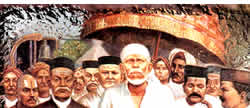



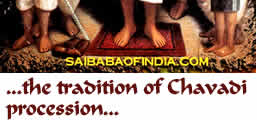
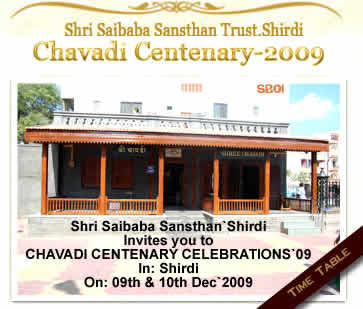
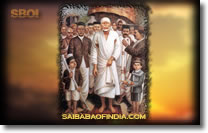


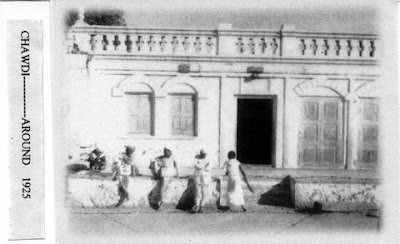.jpg)
.jpg)


.jpg)


